#into (virtual) reality by learning how to do 3d modeling + coding and make a hangout space
Explore tagged Tumblr posts
Text
I wish I could build a cozy cave made of weighted blankets and fluffy pillows with rugs for floors and beanbags everywhere, then invite all my moots over to enjoy hot chocolate and warm tea and sit around a small campfire with sticks of marshmallows in our hands while we take turns picking what music to play in the cave and also with board games and card games everywhere. And a few cats lounging around.
#wait wait wait...#what if i made this wish#into (virtual) reality by learning how to do 3d modeling + coding and make a hangout space#if you would stick with me for a few years this could be us#cozy
2 notes
·
View notes
Text
Why Designers Love Rhino Software
If you’ve ever wondered how designers build those sleek cars, detailed jewelry, or futuristic buildings you see in movies or magazines — there’s a good chance Rhino Software had something to do with it.
Rhino (or Rhinoceros) might sound like the name of a cool band, but in the world of 3D design, it’s one of the most powerful and versatile tools out there. Whether you're sketching ideas, sculpting surfaces, or preparing a model for 3D printing, Rhino is the go-to creative companion for thousands of designers, artists, engineers, and architects around the globe.
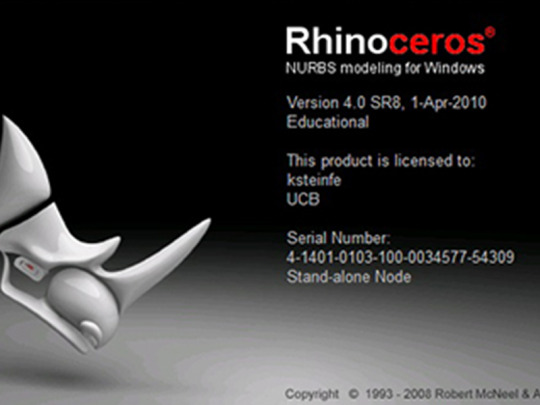
Let’s dive into what makes Rhino so awesome.
So, What Is Rhino?
At its core, Rhino is a 3D modeling software. But unlike other design tools that make you feel boxed in, Rhino gives you complete freedom to build anything — from real-world products to abstract art.
It works with something called NURBS (Non-Uniform Rational B-Splines) — which basically means you can create super-smooth, mathematically precise curves and surfaces. That’s why it’s perfect for designing everything from jewelry to yachts.
Who Uses Rhino?
That’s the fun part — everyone with a creative itch! Rhino has fans in many industries, and here’s how it plays a role in each:
• Architecture: Want to build a futuristic museum? Rhino’s your friend. Architects love it for conceptual designs and detailed blueprints.
• Automotive Design: Every cool curve on a car? Probably tested in Rhino first.
• Jewelry Design: Those delicate rings and intricate pendants? Made easier with Rhino’s precision tools.
• Product Design: From coffee makers to furniture, Rhino helps create the everyday things we love.
• Marine Design: Designing boats and luxury yachts? Rhino sails smoothly here too.
• Game & Multimedia: Game designers and digital artists use Rhino to create models for virtual worlds and CGI.
What Makes Rhino So Cool?
Rhino isn’t just another design app. Here’s why creatives keep coming back to it:
• Freedom to Create – Whether you're drawing freeform curves or modeling something with exact measurements, Rhino lets your imagination take over.
• Easy to Learn – You don’t need to be a tech wizard. The interface is beginner-friendly, yet powerful enough for pros.
• Supports 3D Printing – Rhino makes it super easy to prep your model for 3D printers. Great for hobbyists and professionals alike.
• Affordable One-Time License – No annoying monthly fees if you don’t want them. Buy it once and it’s yours.
• Customizable with Plugins – Want fancy renders? Add V-Ray. Into algorithmic design? Grasshopper is built right in.
A Day in the Life with Rhino
Picture this: You're designing a custom lamp for your workspace. You sketch out the idea on paper, but now you want to bring it to life.
Open Rhino – You start modeling the base using smooth curves and tweak it until it feels just right.
Switch to Perspective View – Now you spin your model around, admire the curves, zoom in for details.
Use Grasshopper – You decide to play with patterns on the lamp's shade using parametric design. Grasshopper makes that easy without coding.
Export for 3D Print – Done designing? Rhino helps you convert your model to STL for 3D printing.
From concept to reality — all in one tool.
The Magic of Rhino + Grasshopper
One of Rhino’s coolest features is Grasshopper, a visual programming language built right into Rhino. Don’t let the “programming” part scare you — it’s all about connecting blocks like Legos.
Want to design a pattern that changes based on sunlight direction? Or a building facade that reacts to temperature? Grasshopper helps you do all that. It’s a favorite among architects and experimental designers who love pushing the limits.
Not Just for Pros!
Here’s the best part: You don’t need a fancy degree or a giant company budget to use Rhino.
• Students use it to build their portfolios. • Freelancers use it for custom product designs and freelance gigs. • Hobbyists use it to design models for laser cutting, 3D printing, or just for fun!
There’s also a great community out there — from Reddit to YouTube — where people share tutorials, plugins, and tips for Rhino users of all levels.
Is Rhino Worth It?
Absolutely.
If you’re serious about 3D modeling or even just curious to explore the digital design space, Rhino is an excellent place to start. It’s reliable, flexible, and gives you room to grow.
https://www.tridaxsolutions.com/product/rhino/
Think of it like a digital sketchbook that also builds things in real life. It lets you be an artist, an engineer, and a dreamer — all at once.
So go ahead — try your hand at modeling that idea you've been thinking about. Rhino might just be the tool that turns your spark of imagination into something real.
0 notes
Text
How VR Development Is Changing the Way We Play and Learn

Virtual Reality (VR) is no longer just a futuristic concept pulled from science fiction—it’s here, and it’s reshaping how we interact with both games and education. By fully immersing users in digital environments, VR creates experiences that are deeply engaging, emotionally resonant, and often more effective than traditional approaches. As developers continue to push the boundaries of VR, they are revolutionizing how we play and how we learn.
A New Era of Gaming
Gaming has always been a leading force in technological innovation, and VR is no exception. In VR, players are no longer looking at the game world through a screen—they’re inside it. This shift has profound implications for the player experience.
Immersion and Presence
The most significant change VR brings to gaming is presence—the feeling of actually “being” inside the game. Instead of pressing buttons on a controller, players can move, reach, look around, and interact with objects using natural gestures. This level of embodiment allows for more intuitive gameplay and deeper emotional investment.
Games like Beat Saber, Half-Life: Alyx, and The Walking Dead: Saints & Sinners showcase how VR can create unforgettable, fully interactive experiences that traditional formats simply can’t match.
Physical Engagement
VR gaming is also more physical. Players often stand, duck, swing their arms, or walk around while playing. This physicality adds a new dimension to gameplay and can even make gaming a form of light exercise. Fitness-focused VR titles, such as Supernatural or FitXR, turn workouts into immersive adventures, blending entertainment with health.
Social and Shared Spaces
VR development is also enabling new forms of social interaction in games. Multiplayer VR experiences like Rec Room, VRChat, and Population: One create spaces where users can talk, gesture, and collaborate almost as if they were physically together. This blending of gaming and social networking is redefining online interaction.
Transforming Education Through VR
While VR has obvious entertainment value, its impact on education is just as powerful—arguably more so. Traditional learning often struggles to engage students or deliver hands-on experience, but VR addresses both challenges.
Learning by Doing
VR makes experiential learning possible. Rather than reading about the solar system, students can travel through it in a virtual spaceship. Instead of watching a video about the human body, they can step inside one, exploring organs in 3D.
This “learn by doing” model improves retention and understanding. For example, medical students use VR to practice surgical procedures in a risk-free environment, while engineering students can manipulate virtual machinery without costly equipment.
Accessibility and Inclusion
One of VR’s most exciting potentials in education is accessibility. Remote learners, students in under-resourced schools, or people with disabilities can access rich, interactive content from anywhere. Virtual field trips, for example, can bring students to historical landmarks, ecosystems, or foreign cities without the logistical challenges of travel.
Additionally, VR can be tailored to individual learning styles—visual, auditory, and kinesthetic—making learning more inclusive and personalized.
Safe Simulations and Scenarios
In fields like aviation, emergency response, or military training, VR offers safe environments for high-risk learning. Trainees can practice decision-making, strategy, and technical skills without real-world consequences. This kind of simulation-based training is already being adopted by airlines, fire departments, and hospitals.
The Developer’s Role in Bridging Fun and Function
The key to all these advances lies with VR developers—creators who blend storytelling, design, psychology, and engineering. Developing for VR is not just about coding 3D environments; it’s about understanding how humans perceive and interact with space, sound, and motion.
Whether building a fantasy game or a virtual chemistry lab, developers must solve for comfort, usability, and realism. That means considering frame rates to prevent motion sickness, creating intuitive controls, and designing environments that encourage exploration.
Game developers are now collaborating with educators, psychologists, and scientists to create experiences that are both entertaining and educational. The line between “playing” and “learning” is becoming increasingly blurred—and that’s a good thing.
Challenges and the Road Ahead
Despite its promise, VR development still faces hurdles:
Cost and Accessibility: High-end VR hardware can be expensive, limiting widespread adoption. However, mobile-based and standalone headsets like Meta Quest are helping to reduce this barrier.
Content Creation: Building VR content is time-consuming and resource-intensive. Tools and platforms are improving, but small developers often struggle to keep up.
Motion Sickness: Some users still experience discomfort in VR. Developers must continually refine movement systems and reduce latency to improve comfort.
As hardware becomes cheaper and more powerful, and as development tools become more accessible, VR’s influence will continue to grow.
Conclusion
Virtual Reality is reshaping how we play and how we learn—turning games into full-body experiences and transforming education into an immersive, hands-on adventure. Developers stand at the forefront of this evolution, crafting digital worlds that entertain, educate, and engage on a level never before possible.
The worlds being built today are laying the foundation for tomorrow’s classrooms, playgrounds, and workplaces. With VR, the boundaries between fun and function are dissolving, and we’re only beginning to see the possibilities.
Get to us
VR Duct Aldwych, London WC2B 4HN
Ph: 020 8050 6021
0 notes
Text
What Can You Do with Game Design Courses? - United Institute of Design

Video games are not just a form of entertainment anymore - they are a global industry that combines art, technology, storytelling, and invention. Video games are everywhere, from smartphones to consoles and also in the form of virtual reality headsets and there is a huge demand for skilled individuals who can create games. If you are thinking of a career that combines both creativity and technology, taking game design courses might be your first step.
So, what can you actually do with a bachelor of game design? Let's look at some of the exciting things that a pathway with a graduate in game design can do.
Understanding Game Design: More Than Just Playing Games
Game design involves the task of conceiving, creating, and refining the rules, structure, and experience of a game. While gamers get to enjoy the end product, there is a lot of tedious work involved, including world-building, character design, code implementation, and sound integration.
Game design courses provide students with an understanding of how to balance creativity with realism, the imagination that goes into designing levels that will attract a player and the methods various humans use to react while playing. You will learn to use industry-standard applications such as Unity, Unreal Engine, Blender, and Maya.
At UID, the B.Design (Hons.) in Animation & Game Design program consistently creates learning opportunities that instill technical skill as well as innovative thinking in gameplay, storytelling, and immersive design.
Career Opportunities After Game Design Courses
A bachelor of game design opens the door to many exciting and dynamic roles in the gaming industry and beyond. Here's what you can do after completing your course:
1. Game Designer
This is one of the most sought-after careers available. Game designers establish the baseline for the game: rules, challenges, the environment, levels, and how players advance through the game. Designers would generally work with artists, programmers and producers to create the game.
Key skills: storytelling, level design, logic, and user engagement.
2. Game Developer / Programmer
If you enjoy coding, and want to make ideas into playable games, then you may want to think about being a game developer. Developers write the code that makes the game run in the way the designer wants it to work. Developers may code to a platform (mobile, console or PC) or code to a game engine (Unity, Unreal, etc.).
Key skills: C++, C#, JavaScript, debugging, and physics simulations.
3. Level Designer
The level designer builds the individual levels, missions, or stages of the game. Level designers use their creativity and strategic thinking to build balanced, fun experiences for players.
Key skills: spatial thinking, user flow, and scripting.
4. Game Artist / Animator
Designers will design the visual graphic style of the game, which involves the characters, environments, objects, and effects in the game. A majority of the work includes modeling, animation, and texturing which will occur primarily in 3D game development.
Key skills: 2D/3D design, modeling, rigging, character animation.
5. Game Tester / QA Analyst
Game testers play new games to discover bugs or glitches that developers must overcome. They will also find balance issues in new games, which get fixed based on tester feedback as a game gets polished by the developers.
Key skills: attention to detail, problem-solving, written communication.
6. Narrative Designer / Script Writer
In story-based games, the narrative designer will be the person responsible for implementing the game's story, dialogues, and world-building into the game. For story-based games, the narrative designer's task is to make the narrative flow naturally through what the player does in the game.
Key skills: writing, character development, storytelling mechanics.
7. UI/UX Designer (Game Interfaces)
User Interface (UI) and User Experience (UX) designers guarantee that players enjoyably and easily maneuver menus, controls, and systems in casual and complex games alike. With an unsuspecting amount of responsibility, UI/UX designers play a crucial role in the design process.
Key skills: wireframing, prototyping, user testing, visual design.
8. Sound Designer / Composer
Sound is the third tool of fascinating abilities in game design collaboration, alongside graphics and gameplay. Sound designers create sound effects, ambient sounds, and music that can elevate the gaming experience.
Key skills: audio editing, composition, mixing, game audio engines.
Beyond Gaming: Expanding Opportunities
With a bachelor of game design, you're not limited to the gaming industry alone. Game design skills are transferable to other sectors like:
AR/VR Development: Used in education, medicine, and training simulations.
Film & Animation Studios: Especially for VFX and interactive storytelling.
Advertising & Marketing: Gamified apps and immersive brand experiences.
Education Tech: Interactive learning tools and educational games.
Simulation and Training: For aviation, military, healthcare, and industrial use.
Why Choose UID for Game Design Courses?
At UID, game design courses are part of the well-rounded B.Design (Hons.) in Animation & Game Design program. UID offers the perfect environment to learn, experiment, and grow as a designer.
Here’s what makes UID stand out:
Cutting-Edge Curriculum: Covers both animation and game design, giving you dual skills.
Studio-Based Learning: Access to high-end labs, software, and creative spaces.
Experienced Faculty: Industry professionals guide you throughout your journey.
Industry Exposure: UID connects you with real-world projects, internships, and expert mentors.
Creative Culture: Collaborate with students across different design disciplines and build a strong portfolio.
Game design is a dynamic and exciting space with immense potential for creativity! With the game industry quickly expanding globally, game design courses can be your pathway into one of the most exciting career options out there today. Whether you want to develop a mobile game that becomes the next best thing or you want to build vast virtual worlds or create incredible characters for AAA games, a Bachelor of Game Design will equip you for success! What are you waiting for? Ready to turn your passion for games into your career? Please check out UID's B.Design (Hons.) in Animation & Game Design!
Blog Source -- What Can You Do with Game Design Courses
#best fashion design college#animation and game design courses#interior & furniture design#game design and development#game design courses gujarat#game design courses
0 notes
Text
How Augmented Reality is Shaping the Future – A Look into Virtual Filaments’ Vision
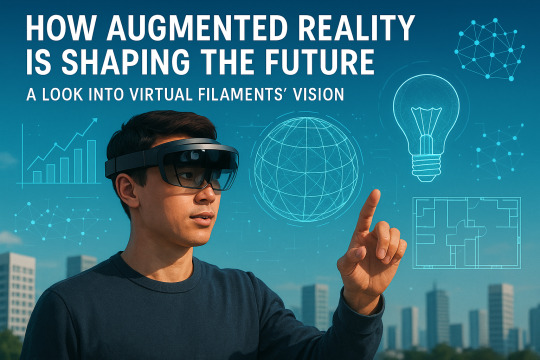
Introduction In today’s fast-evolving digital landscape, Augmented Reality (AR) is no longer a futuristic concept it’s the now. From enhancing customer engagement to redefining how we experience content, AR is driving the next wave of immersive digital transformation. At the forefront of this revolution is **Virtual Filaments a tech-first company leveraging cutting-edge solutions to shape the future.
What is Augmented Reality? Augmented Reality blends digital information images, sounds, or other data into our real-world environment in real-time. Unlike Virtual Reality, which immerses users in a completely digital space, AR enhances the physical world, making it more interactive and informative.
Virtual Filaments + Augmented Reality: A Powerful Combination At Virtual Filaments, technology is more than a tool it's a craft. The company seamlessly integrates AR with innovative solutions for brands, startups, and enterprises. Here's how:
1. Next-Gen User Experiences
AR allows users to experience products before purchasing be it trying on virtual wearables or visualizing furniture in their homes. Virtual Filaments designs these immersive experiences, driving better engagement and decision-making.
2. AR-Powered Applications
From mobile apps to smart devices, Virtual Filaments builds AR-powered solutions tailored for education, retail, marketing, and healthcare. These apps not only inform but also interact, helping users connect deeply with content.
3. Interactive Product Demos
For companies looking to stand out, AR product demos are a game-changer. Virtual Filaments helps brands bring their products to life, offering potential customers a hands-on experience without physical presence.
Why Augmented Reality Matters Now In a digital-first world, attention is currency. AR doesn't just capture attention it holds it. As industries adapt to hybrid and remote-first models, AR becomes essential in marketing, training, and customer support.
Industries That Benefit from AR with Virtual Filaments
Retail & E-Commerce: Virtual try-ons and 3D previews
Education: AR learning aids for interactive teaching
Healthcare: Visual simulations for diagnosis and training
Real Estate: Virtual property walkthroughs
Events & Marketing: Engaging campaigns that drive ROI
The Virtual Filaments Edge With a deep understanding of tech ecosystems and user behavior, Virtual Filaments isn’t just building AR solutions they’re shaping meaningful experiences. Their team bridges creativity and code to deliver scalable, high-performance AR systems that evolve with your brand.
Conclusion As we move deeper into the digital age, Augmented Reality will be at the heart of how we learn, shop, connect, and experience the world. Virtual Filaments is not just following this trend they’re leading it. Ready to explore what AR can do for your brand?
Visit virtualfilaments.com and turn your ideas into immersive realities.
#ImmersiveTechnology #AugmentedReality #ARforeducation #ARinnovations #ARsolutions
0 notes
Text
Screen Guards with Embedded AR Filters: Bringing Augmented Reality to Life
Augmented reality (AR) is no longer confined to high-end gaming apps or futuristic gadgets. It has slowly made its way into everyday devices, changing how we interact with the digital world. But what if your screen guard could enhance your AR experience, adding an extra layer of magic to your smartphone or tablet?
Enter screen guards with embedded AR filters — a concept that blurs the line between the physical and digital worlds. These innovative screen protectors promise to make AR experiences smoother, more immersive, and even more interactive. But how exactly do they work, and are they worth the hype?
How Do AR-Enabled Screen Guards Work?
AR-enabled screen guards are designed with a thin layer of specialized material that interacts with augmented reality applications. These screen guards can contain:
Micro-Lenses or Holographic Layers – These layers help enhance the AR experience by improving depth perception and object tracking.
Embedded NFC or QR Codes – Pre-programmed tags embedded in the screen guard can trigger AR effects or launch apps when scanned by a phone’s camera.
Anti-Glare and High-Clarity Layers – To prevent interference with the phone’s camera and maintain optimal image quality for AR applications.
When your phone’s camera detects the embedded patterns or codes, it activates AR elements that overlay digital information onto the real world. The screen guard becomes an integral part of the AR experience, bridging the gap between what you see and what your device processes.
What Can AR Screen Guards Do?
Enhanced Gaming Experience Imagine playing AR-based games where objects or characters seem more vivid and life-like because the screen guard improves the depth perception and reduces glare. Whether you’re chasing Pokémon or battling virtual enemies, the interaction feels more realistic.
Interactive Learning for Kids AR screen guards can bring textbooks to life. Children can scan illustrations to see 3D models, animations, or interactive lessons, turning education into an engaging adventure.
Virtual Shopping and Try-Ons With embedded AR filters, you could try on clothes, glasses, or makeup virtually by simply pointing your phone’s camera at yourself. The enhanced AR layer can provide more accurate and realistic previews, helping you make better shopping decisions.
Architectural and Interior Design Previews Planning a home makeover? AR screen guards can help visualize how different furniture or decor items would look in your space, with more accurate placement and dimensions.
Guided Tours and Museum Experiences When visiting a historical site or museum, an AR screen guard can trigger additional information, animations, or audio narrations as you move your phone around the environment.
Benefits of AR-Enabled Screen Guards
Improved Visual Clarity AR screen guards minimize glare and reflections, ensuring that AR elements are sharp and clear. This significantly enhances the overall experience.
Seamless Integration with AR Apps Since these screen guards are designed with AR compatibility in mind, they work seamlessly with most AR apps without compromising responsiveness.
Increased Interaction and Engagement Whether it’s for entertainment, learning, or shopping, AR screen guards make the user experience more immersive and engaging by merging the digital and physical worlds.
Protection with Functionality Beyond enhancing AR experiences, these screen guards still serve their original purpose — protecting your device from scratches, smudges, and cracks.
Challenges and Limitations
While the concept of AR-enabled screen guards is exciting, there are a few hurdles that need to be addressed:
Compatibility Issues Not all devices and AR apps may be optimized to take full advantage of these specialized screen guards. Device compatibility could be a limitation for many users.
Cost Factor Integrating micro-lenses, holographic layers, or NFC technology increases the cost of production, making these screen guards more expensive than regular ones.
Durability Concerns AR-enhancing layers are delicate and might wear out faster than traditional screen protectors, raising questions about long-term durability.
Potential Camera Interference Although they are designed to enhance AR experiences, poorly designed AR screen guards might cause unwanted reflections or reduce camera accuracy.
Are AR Screen Guards the Future of Augmented Reality?
As AR technology continues to evolve, integrating it into everyday accessories like screen guards seems like a natural progression. These innovations could redefine how we use AR in daily life, making it more accessible and interactive for a wider audience.
While AR screen guards are not yet mainstream, they offer a glimpse into a future where augmented reality seamlessly blends with our environment. As manufacturers refine this technology and overcome initial limitations, these screen guards may become a staple accessory for tech enthusiasts, educators, and creative professionals alike.
Final Thoughts: Merging Protection with Innovation
Screen guards with embedded AR filters could revolutionize how we interact with augmented reality, offering a richer and more immersive experience while protecting our devices. As the demand for AR experiences grows, these screen guards might soon become an essential part of our digital toolkit, bringing a whole new dimension to everyday smartphone use.
0 notes
Text
Augmented Reality Software: Elevating Everyday Experiences
Imagine trying on clothes without stepping into a store, learning history by walking through a virtual ancient city, or fixing your car with holographic guides floating in front of you. Augmented reality (AR) software makes this possible, blending digital magic with the real world to enrich how we live, work, and play. These tools overlay virtual elements—like 3D models, text, or animations—onto our surroundings, creating experiences that inform, entertain, and inspire. What makes AR software a daily essential, and how can it transform your routine? Let’s dive in.
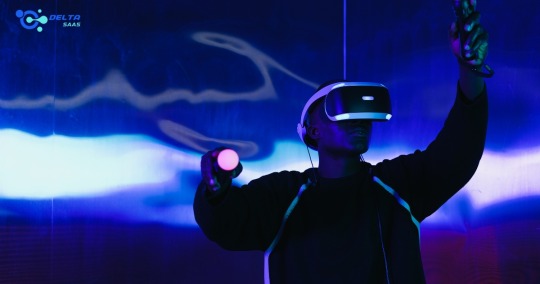
What is Augmented Reality Software?
Augmented reality software is a collection of digital tools that superimpose computer-generated content onto the physical world in real time. It’s the tech behind apps that let you see how a couch fits in your living room or play games where characters leap off your coffee table. Unlike virtual reality, which dives fully into a digital realm, AR enhances what’s already there, using devices like smartphones, tablets, or AR glasses.
Today, these platforms tap into artificial intelligence (AI), cloud computing, and advanced sensors to deliver seamless, interactive experiences for everyone from casual users trying a new hairstyle to professionals designing innovative products.
Why Augmented Reality Software Matters
Our world is visual, fast-paced, and information-hungry. AR software bridges the gap between curiosity and understanding by making the abstract tangible. It matters because it:
Enhances Learning: Visualize complex ideas, from anatomy to architecture.
Boosts Convenience: Preview products or navigate spaces with ease.
Sparks Joy: Turn mundane moments into playful adventures.
Saves Effort: Solve problems with step-by-step AR guidance.
Posts on X often highlight tools like Adobe Aero for creative fun, showing how AR is weaving into daily life.
Key Features of Augmented Reality Software
The best AR software offers a dynamic toolkit:
Real-Time Overlay: Place 3D objects or data in your environment instantly.
Tracking Tech: Align virtual content using cameras, GPS, or markers.
Interactivity: Tap, swipe, or speak to engage with AR elements.
Customization: Build tailored experiences with templates or code.
Cross-Platform: Run on phones, tablets, or headsets smoothly.
AI Smarts: Recognize objects, faces, or spaces for richer overlays.
These features turn your device into a window of possibility.
Top Benefits for Users
AR software delivers everyday wins:
Engagement: Captivate your attention with immersive visuals.
Practicality: Try before you buy or learn by doing, hands-on.
Time Savings: Skip guesswork with instant previews or guides.
Accessibility: Use AR anywhere with just a smartphone.
A shopper using IKEA Place might save a trip to the store, while a student on Merge Cube explores science in 3D from their desk.
Popular Augmented Reality Software
The AR landscape is buzzing with options:
Adobe Aero: Free, intuitive tool for crafting AR scenes.
Unity: Developer favorite for robust AR apps across platforms.
ARCore: Google’s SDK for Android AR magic.
ARKit: Apple’s toolkit for iOS AR brilliance.
Snap Lens Studio: Social-friendly AR for fun filters and effects.
How to Choose the Right Augmented Reality Software
Picking the right tool depends on your vibe:
Purpose: Casual fun (Snap) or app-building (Unity)?
Skill Level: Beginner-friendly (Aero) or pro-grade (ARKit)?
Device: Android (ARCore) or iPhone (ARKit)?
Features: Need simple overlays or advanced tracking?
Cost: Free (Aero) vs. paid tiers (Unity Pro at $150/month)?
The Future of Augmented Reality Software
AR software’s future is dazzling. AI will make overlays smarter—think real-time translations popping up on signs or personalized shopping tips as you browse. AR glasses will replace bulky headsets, blending tech into daily wear. 5G will cut lag, making experiences instant, while social AR could let friends join your virtual world from afar. The focus is on seamless, everywhere AR that feels as natural as breathing.
Challenges to Watch For
There are quirks. Learning tools like Unity can take time for novices. Device limits—older phones might stutter—mean you need decent hardware. Costs can climb; premium AR tools aren’t always cheap. Privacy matters—cameras scanning your space raise questions, so pick secure platforms. Battery drain is real too—AR loves power, so keep a charger handy.
Real-World Impact
Shoppers: Use IKEA Place to see furniture in your home before buying.
Learners: Explore planets with Google Expeditions in AR.
Hobbyists: Paint in 3D space with Tilt Brush via AR headsets.
Conclusion
Augmented reality software isn’t just tech—it’s a lens that makes life richer, easier, and more fun. It turns your phone into a portal, blending the real with the imagined to solve problems, spark creativity, and connect us in new ways. Whether you’re designing, shopping, or just playing, the right AR tool can redefine your day. Explore the possibilities, grab a tool, and see your world in a whole new light.
Frequently asked questions
What is augmented reality software?
It’s a set of tools that overlays digital content—like 3D models or text—onto the real world in real time via devices like phones or glasses.
Who uses augmented reality software?
Everyday folks, students, shoppers, creators, and pros in fields like education, retail, or design looking to enhance their experiences.
How does it improve daily life?
It simplifies decisions, boosts learning, and adds fun by merging virtual info with your surroundings.
Is it secure?
Most trusted tools encrypt data and prioritize privacy—check each app’s policies to be sure.
What’s the difference between AR and VR software?
AR enhances reality with digital overlays; VR immerses you fully in a virtual world.
How much does augmented reality software cost?
Ranges from free (Adobe Aero, ARCore) to $50-$150/month for pro versions (Unity, Vuforia).
Can it integrate with other tools?
Many sync with design apps, cloud storage, or social platforms—confirm what fits your needs.
How long until I see benefits?
Simple uses like previews work instantly; deeper perks grow with practice and exploration.
0 notes
Text
How Augmented Reality Models Help People in Purchasing Products from the Market?

Introduction
With the rapid advancement of technology, shopping has transformed drastically. One of the biggest game-changers in the retail industry is augmented reality models. These models provide an interactive and immersive experience that allows customers to visualize products in real-world settings before making a purchase.
With the help of AR 3D modeling, shoppers can see how furniture looks in their homes, try on clothes virtually, or even check how a car would fit in their garage—all without physically visiting a store. Businesses now rely on 3D modeling services and 3D product modeling services to create highly detailed, realistic product representations that enhance the shopping experience.
But how exactly do augmented reality models help consumers in purchasing products? Let’s explore their impact on modern retail.
1. Enhancing the Online Shopping Experience
E-commerce has become the preferred way to shop, but one major drawback is the inability to see, touch, or try products before purchasing. AR 3D modeling solves this issue by allowing customers to interact with virtual product models. For example, customers can use their smartphones to place a 3D product modeling service of a sofa in their living room and see if it matches their decor.
2. Improving Customer Confidence in Purchases
One of the biggest reasons for product returns in online shopping is customer dissatisfaction due to unmet expectations. Augmented reality models eliminate this uncertainty by providing accurate, life-like product representations. When customers can examine products in detail using 3D modeling services, they feel more confident in their purchase decisions, reducing the likelihood of returns.
3. Virtual Try-Ons for Clothing and Accessories
Many fashion brands now use AR 3D modeling to enable customers to try on clothes, shoes, and accessories virtually. Instead of guessing how a dress or a pair of sunglasses will look, shoppers can see themselves wearing the items through their smartphone cameras. This interactive feature significantly enhances the shopping experience and encourages more purchases.
4. Furniture and Home Décor Visualization
Imagine buying a new couch or a dining table without knowing if it fits your space. With augmented reality models, home decor shoppers can place 3D product modeling services of furniture items in their homes before making a purchase. Apps from retailers like IKEA and Wayfair use 3D modeling services to help customers visualize products in real-world environments, ensuring they make the right choice.
5. Electronics and Gadgets: Seeing Before Buying
Purchasing expensive electronics like TVs, laptops, or gaming consoles requires careful consideration. AR 3D modeling allows customers to explore product features, view different angles, and even see how devices fit into their spaces. This is particularly helpful for large items like home theater systems, where proper placement is crucial.
6. Car Shopping Revolutionized with Augmented Reality
Buying a car is a big investment, and customers want to be sure they are making the right choice. Augmented reality models let shoppers explore different car models, customize colors, check interior features, and even take virtual test drives. Car manufacturers like BMW and Tesla use 3D modeling services to give customers an immersive, interactive experience.
7. Increasing In-Store Engagement
While online shopping is growing, physical retail stores still benefit from AR 3D modeling. Many brands now offer AR kiosks where customers can scan QR codes and access 3D product modeling services to learn more about products. This interactive approach keeps customers engaged and enhances their in-store experience.
8. Reducing Product Returns and Exchanges
Returns are costly for businesses and frustrating for customers. By using augmented reality models, businesses can minimize returns by ensuring customers get exactly what they expect. Whether it’s a piece of clothing, a gadget, or a piece of furniture, AR technology helps shoppers make more informed decisions.
9. Personalized Shopping Experiences
With the help of 3D modeling services, businesses can create personalized AR experiences for customers. AI-driven AR applications analyze customer preferences and suggest products based on their interests. This personalization increases customer satisfaction and boosts sales.
10. Boosting Sales and Conversion Rates
When customers can interact with AR 3D modeling, they are more likely to complete their purchases. Studies show that AR-driven shopping experiences lead to higher conversion rates because they create a sense of ownership and confidence in the product.
11. Enabling Interactive Marketing Campaigns
Retailers use augmented reality models in marketing campaigns to attract more customers. For example, brands launch AR-based advertisements where customers can interact with 3D product modeling services by scanning a QR code. This innovative marketing approach creates excitement and engagement, leading to increased brand awareness.
12. AR in Grocery Shopping and Packaging
Supermarkets are also adopting AR 3D modeling to enhance the shopping experience. By scanning product packaging, customers can access additional information, recipes, and even step-by-step guides on how to use the product. This adds value to the shopping experience and helps brands stand out.
13. Healthcare and Beauty Products in AR
Many beauty and skincare brands use augmented reality models to help customers try out makeup products before buying. AR beauty apps allow users to apply different lipstick shades, foundation tones, or eye shadows to see what suits them best. This innovative use of 3D product modeling services ensures customers make the right choice without physical trials.
Conclusion
Augmented reality models have revolutionized the way people shop. By integrating AR 3D modeling and 3D product modeling services, businesses offer customers a more immersive, interactive, and personalized shopping experience. Whether it’s fashion, furniture, electronics, or automobiles, 3D modeling services help customers make informed decisions, boost confidence in purchases, and enhance overall satisfaction.
As technology continues to evolve, AR-based shopping will become even more sophisticated, making it an essential tool for both consumers and retailers. The future of shopping is here, and augmented reality models are leading the way.
FAQs
1. How do augmented reality models help in shopping? Augmented reality models allow customers to visualize products in real-world environments, helping them make informed purchase decisions.
2. What industries use AR 3D modeling for sales? Industries like fashion, furniture, electronics, automotive, and beauty use AR 3D modeling services to enhance customer experiences.
3. Can AR technology reduce product returns? Yes, by providing an accurate visual representation of products, AR helps customers make better choices, reducing return rates.
4. Where can businesses get 3D product modeling services? Many companies offer 3D modeling services, including specialized agencies and platforms like Sketch fab, Turbo Squid, and CGTrader.5. Is AR shopping available on mobile devices? Yes, many brands offer AR shopping experiences through mobile apps, allowing customers to interact with products using their smartphones.
0 notes
Text
Top EdTech Innovations to Follow in 2025 🌟
The world of education is evolving at lightning speed, and 2025 is set to be a game-changer for students, parents, and educators alike. From personalized learning journeys to cutting-edge tools, the EdTech landscape is redefining how we think about education. Let’s dive into the top innovations shaping the future! 🚀
1. On-Demand Learning with a Netflix Twist 🎬
Imagine accessing a tutoring session the same way you stream your favorite TV series! On-demand tutoring platforms are doing just that. Students can now dive into lessons or solve tricky problems instantly, choosing topics that resonate with them. Whether it’s algebra, history, or coding, the experience is engaging, dynamic, and tailored. This binge-worthy model ensures learning feels less like a chore and more like an adventure. ✨
2. Hyper-Personalized Tutoring for Every Learner 🎯
Gone are the days of one-size-fits-all education. Advanced platforms are adapting to individual student needs, preferences, and learning styles. With AI-driven insights, students receive recommendations for lessons or exercises that match their interests. Struggling with quadratic equations? The system offers simplified explanations. Love exploring history? It curates content to deepen your curiosity. Learning has never felt so personal! 💡
3. Gamification for Engagement 🎮
Who says learning can’t be fun? Gamified tools are bringing an element of play into education. Think leaderboards, badges, and challenges that make mastering new skills exciting. It’s an approach that encourages progress, builds confidence, and fosters a love for learning—all while having fun! 🌈
4. VR and AR in Education 🌍
Virtual Reality (VR) and Augmented Reality (AR) are taking experiential learning to the next level. Imagine walking through ancient Rome during a history lesson or exploring the molecular structure of DNA in 3D. These technologies create immersive experiences that help students grasp complex concepts more effectively. It’s learning by doing—without leaving the room! 🔬
5. AI Tutors as Study Companions 🤖
AI-powered tutors are becoming smarter, assisting students with instant answers, clarifications, and tailored study plans. These virtual companions are available 24/7, making them perfect for late-night problem-solving or quick review sessions before exams. It’s like having a teacher in your pocket. 🧠
Ready to Take Your Learning to the Next Level? 🌟
With platforms like XpertBuddy, you can:
🕒 Access personalized, on-demand tutoring anytime, anywhere.
🎯 Enjoy lessons and problem-solving sessions tailored to your unique needs.
🌐 Experience seamless learning with AI-powered adaptability and interactive tools.
🚀 Start your journey to academic success today!
Start exploring now: 🌐 Website: https://expertbuddy.com/ 📱 Google Play Store: https://play.google.com/store/apps/details?id=com.instaxpert.xpertbuddy&hl=en_IN 🍎 Apple Store: https://apps.apple.com/in/app/xpertbuddy/id6499415459
Your future is just a click away! 🎓
0 notes
Text
Which STEM lab activities are most popular among teachers?

STEM education has revolutionized the way students learn by integrating Science, Technology, Engineering, Arts, and Mathematics into cohesive, hands-on activities. For teachers, STEM labs are not just classrooms; they are innovation hubs where students explore, create, and learn by doing. But which activities resonate the most with teachers and students alike? Let’s dive into some of the most popular STEM lab activities that are winning hearts in classrooms worldwide.
1. Designing and Building Balloon-Powered Cars
This classic activity challenges students to design cars powered by the simple yet effective propulsion of a balloon. It introduces concepts of motion, force, and energy conservation while leaving room for creative engineering designs.
How It Works:
Students use materials like cardboard, straws, and balloons to construct their cars.
They experiment with different designs to optimize speed and distance.
Why Teachers Love It:
Encourages hands-on exploration of physics principles.
Fosters creativity and problem-solving.
Accessible for students of various age groups.
2. Robotics and Coding Challenges
Robotics and coding have become staples in modern STEM labs. Whether students are programming a robot to complete a maze or using Scratch to create animations, these activities enhance computational thinking and problem-solving skills.
Popular Tools and Kits:
LEGO Mindstorms or VEX Robotics kits for building robots.
Scratch or Python for beginner-friendly coding projects.
Microcontrollers like Arduino for advanced programming.
Why Teachers Love It:
Provides a clear connection between coding and real-world applications.
Builds logical reasoning and sequential thinking.
Engages students with diverse interests.
3. DIY Weather Station
Weather stations allow students to delve into the world of environmental science by building devices to measure weather conditions such as temperature, humidity, and wind speed.
How It Works:
Students assemble sensors or use simple materials to create weather-measuring instruments.
They collect and analyze data to understand weather patterns.
Why Teachers Love It:
Combines engineering with real-world science.
Sparks discussions about climate change and environmental responsibility.
Encourages teamwork and data analysis.
4. Art-Infused STEM Projects
Activities that merge art with STEM concepts are particularly appealing to teachers aiming to nurture creativity. Projects like designing fractal art or crafting models using 3D printing blend technical skills with artistic expression. Learn more
Examples:
Fractal geometry art using math principles.
Sculptures created with 3D modeling software and printers.
Why Teachers Love It:
Makes math and science more approachable.
Appeals to students with artistic inclinations.
Encourages thinking outside the box.
5. Solar-Powered Machines
With the growing emphasis on renewable energy, building solar-powered devices has become a popular STEM activity. Students can create solar-powered cars, boats, or simple machines to learn about energy efficiency.
Why It’s Popular:
Demonstrates the principles of sustainable engineering.
Provides a hands-on introduction to renewable energy sources.
Develops problem-solving and critical-thinking skills.
6. Chemistry Experiments: Making Slime and Beyond
Chemistry experiments, particularly ones involving polymers like slime, are timeless hits in STEM labs. They make abstract chemical concepts tangible and enjoyable for students.
Popular Experiments:
Making slime to explore viscosity and chemical bonds.
Creating a baking soda and vinegar volcano to understand chemical reactions.
Why Teachers Love It:
Easy to prepare with readily available materials.
Visually engaging and fun for all ages.
Sparks curiosity about how substances interact.
7. Virtual Reality (VR) Expeditions
Virtual reality activities are becoming increasingly popular as schools adopt cutting-edge technology. Teachers use VR to take students on virtual field trips or to simulate real-world environments for problem-solving.
Why Teachers Love It:
Offers immersive experiences that traditional labs cannot replicate.
Enhances understanding of complex topics like anatomy, astronomy, or historical events.
Appeals to tech-savvy students.
8. Gardening and Hydroponics Projects
Gardening in a lab? Yes! Teachers incorporate biology, chemistry, and environmental science by teaching students how to grow plants using hydroponic systems.
Why It’s Engaging:
Hands-on exploration of plant biology and ecosystems.
Promotes sustainability and environmental awareness.
Ties science to everyday life.
Start inspiring young innovators today!
The best STEM lab activities are those that spark curiosity and creativity in students while providing a solid foundation in science, technology, engineering, arts, and mathematics. Teachers play a vital role in making these activities exciting and educational. By incorporating popular activities like those mentioned above, educators can ensure their students thrive in a world that demands innovation and critical thinking.
Ready to transform your classroom with engaging STEM activities? Start exploring these ideas today and watch your students soar!
0 notes
Note
Did u give any of ur ocs ur favorite things? Like a little gift- this one gets ur fav foods, that one gets ur fav color.... I sometimes actively give mine things I hate just for some Variety lma o
Oh absolutely- I do this with a lot of characters but, my entomology-loving ocs tend to especially get the brunt of my interests. Like Brianna here:

[ID: A digitally drawn ref, featuring a human character named Brianna. She's dark skinned, fat, with kinky hair and covered in bug-themed imagery- the ref shows her in two different outfits and hairstyles. Her appearance on the left seems more casual, hair stylized into short dreads while wearing simple jeans and a t-shirt with a gem spider logo, with small words underneath spelling out "CRYSTAL SPIDER". She's also wearing some bug themed jewelry and a scorpion-like creature perches on her shoulder. On the right her hair is an afro, and she's instead wearing a white suit with scorpion-tail shaped coat tails and a white hero mask. She has a bowtie shaped like scorpion pincers and a cleome flower pinned to her right lapel. End ID]
I don't give myself the luxury of making a lot of bug nerd characters but, when I do I make them just as passionate about invertebrates as I am. Brianna works in computer/coding related work so she isn't specifically an entomologist but, just like me she has bugs as her special interest. Arachnids (scorpions especially) are her favorite, and combining her two other special interests (coding and superheros) she also became a white-hat, scorpion-themed hacking vigilante on the side, alongside her twin sister. She's SO passionate about bugs that, when she discovered that no one intended to mod insects back into Holocity, (long story short: her entire city perished, but they all returned as a hologram program, and the residents get to modify their own reality [if they have the skills to]), she learned how to 3d model and code AI herself to make some mods and even made her own virtual pet/assistant (scorpion creature on her shoulder). So although her opinions on bugs are a BIT different than mine, I get to impose my bug love onto her :] (and my autism and aroace-ness too hehe)
#u did mention about giving characters things you hate for variety and i also like doing that#for example brainna likes centipedes way more than millipedes even though im the complete opposite#anyway I love her shes awesome#holocity#oc#my art#brianna#bug#insect#scoprion#arachnid
12 notes
·
View notes
Text
Critical Thinking Lecture Part 3
Smart Textiles
We have already identified some of the historical social influences on lifestyle which impacted fashion & textiles and we have started to try and predict how these drivers will impact the future of these industries.
In today’s lecture we investigated innovations that already exist and are being developed for the future of the fashion and textiles industries. These innovations are split into three topics:
Innovative Smart Textiles
Innovative Technology
Innovative Design

Smart Textiles - The development of textiles to improve human’s everyday life, to benefit the industry, the health care sector and the environment. Smart textiles are split into two categories aesthetic and performance enhancing.
Aesthetic Smart Textiles
Wearable technology, the integration of technology and fashion.
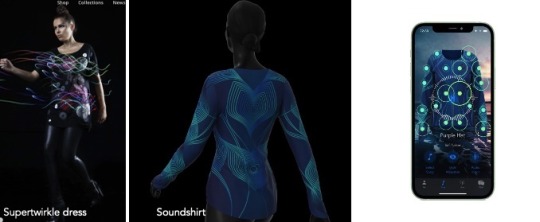
Cutecircuit produce wearable technology: Supertwirkle Dress and a mini dress that reacts to the wearer’s movement by changing colour, The SoundShirt is used for music, hugs, and videogames, and also for access to live concerts creating an immersive augmented and virtual reality experience. The Soundshirt is a wearable device that enables deaf people to experience music.
Mylo Vegan Leather -
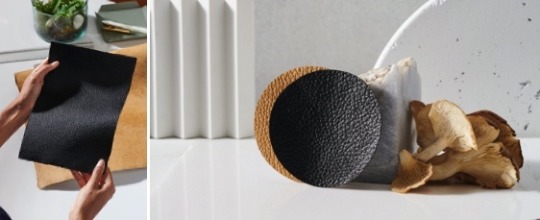
Mylo feels and looks like animal leather, it is grown from mycelium the underground roots of mushrooms. Low impact on environment; 2 week growth period, fewer greenhouse gases, uses less water than animal leather.
Adidas, Stella McCartney, Lululemon and Gucci’s parent company Kering have teamed up to invest in Mylo aiming to create a commercially viable supply chain for the vegan leather.
Performance enhancing textiles:
Futurelight is a smart textile that is breathable, whilst remaining waterproof, “contains holes so tiny, only air can come in and out. Water simply won’t fit”
The fabric can be customised for the weather or geographical demands; protecting hikers from the snow, or provide air ventilation for runners.
After doing more research into Mylo fabric I came across a website called Mylo Unleather. The allure of leather with a sustainable transformation, made from mycelium. The compound latticework of underground fibres are so strong they hold the planet together. Mylo is soft, supple, and less harmful to the environment. Leather has served humans for centuries, people have evolved and so should materials. In our resource-constrained world with a growing population, we are overdue for a renewable, sustainable alternative to leather.
Unleather - The radical act of choosing products made sustainably with infinitely renewable mycelium over animal and synthetic-based materials.
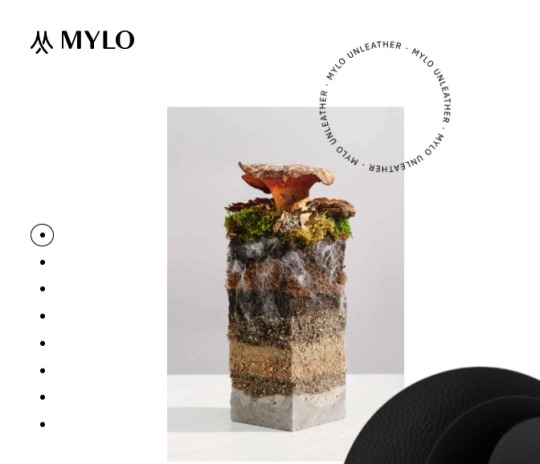
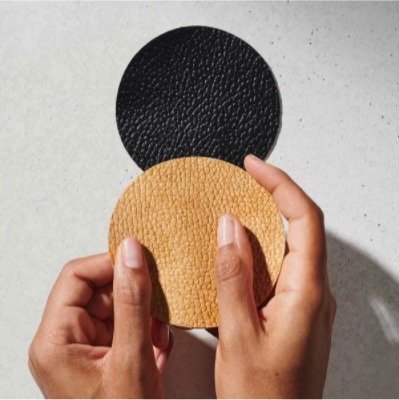
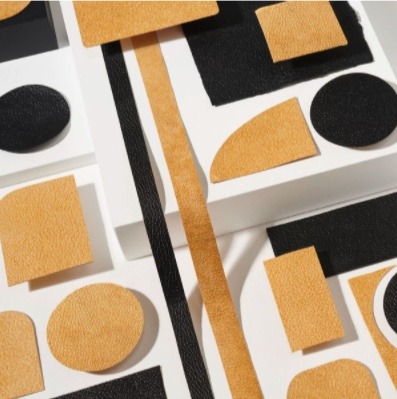
Mylo can be used like animal or synthetic leather, and can take on any colour, emboss, or texture. Mylo has an unmistakable resemblance to animal leather, but with an unbelievably low environmental impact. Mylo consumes less land and emits fewer greenhouse gases than raising livestock. The mycelium used to make Mylo is grown from mulch, air, and water in just a few short weeks, versus the years it takes to raise cattle. Mylo is certified bio-based, which means it’s made predominantly from renewable ingredients found in nature today.
Using Green Chemistry principles, Mylo is created through a highly efficient process that is designed to reduce environmental impact from start to finish.
Mylo would definitely be a suitable fabric to use as an alternative to leather. It fits the brand's identity of sustainability perfectly and if our brand was to use leather-like fabric, mylo would be the best choice.
Textiles of tomorrow will actively help share and potentially save it.
Organic Basics - Polygiene
Self healing fabrics - damaged waterproof fabrics that melt at very low temperatures to repair.
New smart material will form instant casts for accident victims.
Modified cotton cleans itself when exposed to sunlight.
Clothes that dissolve and disappear may solve fashion’s sustainability crisis.
Chromosonic a fabric that can turn you into chameleon (US Military).
Biocuture - grown fabric.
Sustainable self-washing underwear.
In the future, your clothes will clean the air, generate power and save life.

Programmable - the ability of a material to change shape on demand.
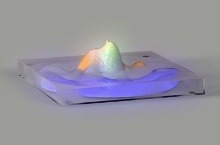
Self-healing - materials that are able to repair themselves will not only increase product lifespan but also allow them to operate effectively in hostile environment.

Genetically Engineered - the manipulation of biological systems to grow a new generation of materials that grow a new generation of materials that can be controlled at a molecular level.

Purifying - materials that have the ability to filter out environmental hazards, creating pollution-free habitats.

Transient - limited-lifespan materials reducing the impact of single-use packaging.
Technology - the application of scientific knowledge for practical purposes, especially in industry. Machinery and equipment developed from application of scientific knowledge. Google translate.
We then started to look at the following innovative technologies -
3D digital clothing collection.
Augmented pattern design - mission to reduce waste.
Blockchain technology.
Digital Clothing -
“Our value proposition is the dematerialisation of fashion” Hernandez 2021.

The Dematerialised - ending the future of fast fashion.
Positives -
Larger outlet for creativity and experimentation.
Decreases the damaging impact on the environment.
Retailers can address more varied demographics.
Reduces global supply chains replaced by digital space.
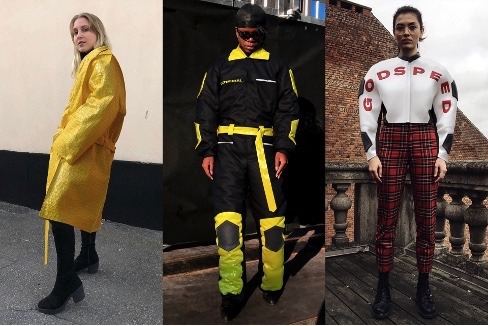
Vogue Business in 2019 Carlings released its first digital clothing collection; 19 genderless, size less pieces priced between 10-30 curos each, with a limited run of up to 12 garments. The customer’s photos were uploaded for Carlings to dress in the purchased outfit. Influencers were used to promote the collection, which was sold in a week.

Current concerns for the development of digital clothing for fashion brands -
Fashion designers are not trained in 3D modeling and sample patterns are not easily converted to 3D models.
3D artists would be needed, at a cost!
Growth of digital tailors required.
Codes do not exist for all fabrics i.e. wool & silk.
Innovative Technology + Innovative Design = Better fitting sustainable clothing.
Fashion design practice wastes 15% fabric.
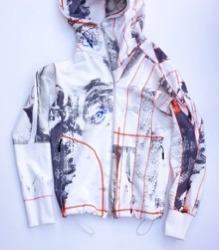
Synflux has come up with a way to reduce fabric waste by creating clothes that fit a person’s body perfectly. The Algorithmic Couture project uses 3D- scanning to determine the measurements and then runs machine- learning algorithms to find the optimum design pattern, brining fabric waste to zero. Springwise.com
Blockchain Technology -
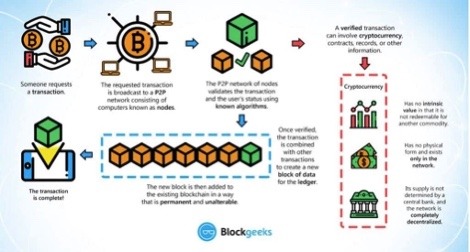
A digital record that cannot be altered, that details a product originality (genuine or an imitation) which will assist with specifying a product’s safety and ethical standards. Invaluable to limit the counterfeiting market and to help with the growth of sustainable fashion industry. Chitrakorn, K (2018).
Prevents fraud as all components are traceable.
Faster supply & purchasing of goods (technology still developing).
Records the product from source - manufacturing - retail, verifying its sustainability.
Innovative Design -
Artificial Intelligence Fashion Design.
3D Printed Fashion.
Artificial Intelligence Fashion Design -

Acne Studios use Al technology alongside generative artist Robbie Barrat to design and manufacture a fashion range for A/W 2020. A combination of algorithms and thousands of classic Acne designs were fed into the Al technology to design & produce the range.

The runway show presented perforated shirts that referenced digital glitches, polo shirts without buttons (as the neural network did not understand buttons), and distorted snake prints covering the entirety of suits and oversized cape-like coats.
3D printing - the process of making 3 dimensional solid objects from a digital file.
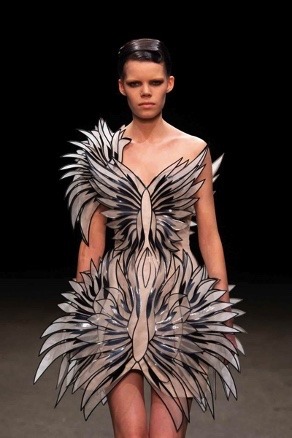
Positives of 3D printed fashion -
Custom-designed clothing.
Environmentally friendly; reduce waste, use of water & dyes.
New fibres being developed that are so fine that they are comparable to cotton reducing heavy pollutant cotton farming.
Increase speed to market and supply chain, garments and footwear can be printed within 24 hours.
Prototyping & sample made - cheap and time-efficient
Negatives of 3D printed fashion -
File piracy, authenticity.
Loss of manufacturing jobs.
Quality control, customers printing their own products.
Have we reached the limit of 3D printing -
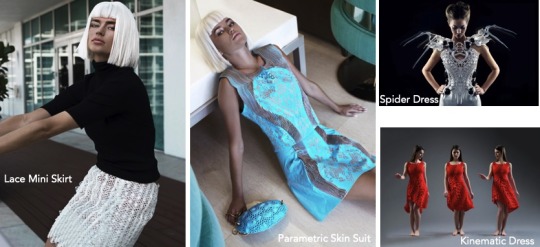
The Spider Dress of Anouk Wipprecht has mechanical arms that extend and retract as a response to external stimuli when people approach. The wearer’s own breath will help to signal the defense posture of the robotic arms. The dress is fully 3D printed with the Selective Laser Sintering technology.
2 notes
·
View notes
Text
All the Cool Augmented Reality (AR) Things Your iPhone Can Do Right This Minute
With AR on your iPhone, you can create interactive art installations, view constellations in the night sky, and even bring museum exhibits to life through your phone's camera. AR-enabled apps like IKEA Place and Houzz allow you to virtually place furniture and decor in your home before making a purchase, while apps like Snapchat and Instagram offer fun AR filters and effects to enhance your photos and videos. Educational AR experiences like Civilisations AR and WWF Free Rivers let you learn about history and nature in an immersive way, while AR games like Harry Potter: Wizards Unite and Jurassic World Alive bring your favorite fictional worlds to life. AR is also useful for practical tasks, like measuring distances and angles, scanning QR codes, and even translating signs in real time. With all the possibilities of AR on your iPhone, the only limit is your imagination.

Augmented Reality for iPhone Augmented Reality for iPhone uses the device's camera and sensors to overlay digital content onto the real world, creating interactive and immersive experiences for games, education, shopping, and more.
Shopping Apps IKEA Place IKEA Place is an AR-enabled app that lets users virtually place furniture and decor from IKEA's catalog in their homes. Using the iPhone's camera and AR technology, users can see how furniture will look and fit in their space before making a purchase.
Edmunds Car App The Edmunds Car App provides car shoppers with an easy-to-use tool for researching, pricing and comparing vehicles. The app also features a built-in car scanner that allows users to scan a vehicle's VIN number and receive instant information about its make, model, and value.
Modiface Modiface is an AR-powered beauty app that allows users to try on makeup and hairstyles in real time using their iPhone's camera. The app uses advanced facial recognition technology to accurately apply virtual makeup and simulate hairstyles, helping users find their perfect look before making a purchase.
Game Apps My Very Hungry Caterpillar My Very Hungry Caterpillar is an interactive AR app that brings the classic children's book to life. Users can care for their own virtual caterpillar, feed it, play with it, and watch it grow into a beautiful butterfly through the app's AR technology.
Monster Park Monster Park is an AR game that lets users capture and battle virtual monsters in the real world. Using the iPhone's camera and GPS, players can explore their surroundings to find and collect monsters, then train them and battle against other players in real time.
Learning Apps Visual Body Visual Body is an AR-powered medical education app that allows users to explore and interact with a 3D model of the human body. With detailed anatomical features and interactive simulations, the app helps medical students and professionals learn about the human body in a more immersive and engaging way.
Useful Apps Pixie Pixie is an AR app that helps users locate lost items by creating a digital map of their belongings. Users can attach Pixie Points to their items, then use the app to locate them using the iPhone's camera and AR technology. The app also features a virtual assistant for reminders and notifications.
TapMeasure TapMeasure is an AR-enabled measuring app that lets users measure real-world objects using their iPhone's camera. With advanced computer vision and AR technology, the app can accurately measure distances, angles, and surfaces, making it a handy tool for home renovation and DIY projects. The article highlights various AR capabilities available on iPhone devices, including virtual furniture placement, makeup and hairstyle try-on, educational experiences, and practical tasks like distance measurement and sign translation. The range of AR applications on the iPhone is vast and continues to expand, offering endless possibilities for users.
0 notes
Text
What abilities are required of motion graphics designers?
During your time at the MAAC Pune design institute, you will acquire the fundamentals of design and essential techniques. You will learn about color theory, typography, and many other elements used to create eye-catching artwork as you develop your skills.
We polled motion graphic designers to find out what they felt were the most crucial technical and soft abilities for their position today.
3-D rendering
Calligraphy and two-dimensional art are still relevant, according to Joseph. But 3-D modeling, which is a major component of the future of graphics, is now the foundation for the majority of motion graphics. Working with modeling software, according to Joseph, is the key to comprehending points in three-dimensional space, the lines that connect them, and the polygons formed by those lines.
Animation viewpoint
"A good 3-D designer understands motion and timelines," claims Joseph. 'Things can move. Light sources can also. The audience's view is provided by the camera, which can also move. One element at a time, the choreographer can create intricate movements that can branch out in numerous directions.
Organization
Andres asserts that both independent contractors and team members must be organized. The bigger your projects get, the more important it is to maintain a tidy file with organized assets, dependencies, layers, etc., according to Andres.
According to Avola, "organization and the ability to multitask are critical qualities we look for in new motion designers." You'll be handling numerous levels and components at once. Keep your files organized; failing to do so could cost you later.
routine animation
The fact that making motion graphics might take a lot of time is one of the main difficulties. Using procedural animation can help reduce that.
According to Avola, "the word 'procedural' has had a revival in recent years, and this tendency is projected to explode over the next ten years. "Procedurally generated, entire animations can be produced in a fraction of the time using basic and complicated algorithms. Automated methods make it easy to adjust, adapt, and revise work.
Avola claims that in order to speed up the creative process, motion design software is increasingly using scripts, expressions, and code. Procedural animation, for instance, enables designers to apply predetermined physics to 3D objects; for instance, if two objects clash in an animation at a specific speed, the outcomes are foreseeable and may be modelled correctly.
Lighting and texture effects
"The audience doesn't see the model, they see the shapes and the images," claims Joseph. He underlines how surfacing contributes to the appearance of photo-realistic 3D visuals. Surfaces may be glossy, reflective, translucent, rough, or refractive. They can also show moving pictures or simulate textures. The possibilities are endless.
recognizing the overall context
"A good designer knows what their designs will be used for," Joseph asserts. He underlines the growing potential for motion graphics artists in the fields of video, multimedia, game design, and virtual reality. However, every application is unique and requires a unique strategy. Recognize each of these uses and how to prepare for them.
Adaptability
Avola explains that professional motion designers must be prepared to modify their original vision in order to take customer feedback into account. "Plans change, as do project scope and goals," she says. "Remain humble and take the blows as they come."
Timing
According to Avola, timing is one of the hardest and most crucial talents for a motion graphics designer. The best tales have a natural flow and rhythm, and motion design is a technique that is heavily influenced by storytelling.
A graphic that is incredibly detailed and generally attractive is ineffective if the pacing is off or doesn't blend well with other components, such as sound. The greatest motion designers and animators develop the ability to modify their work and incorporate rhythm and tempo into their workflow.
0 notes
Text
Submit Your Work to GeneratedArt Publications on Medium

Do you have a passion for generative art, AI art, creative coding, or generative design? Are you looking to share your insights, ideas, and stories with a wider audience? Submitting your Medium story to GeneratedArt publications can be a great way to get your work seen by people who share your interests. In this article, we will walk you through the steps to submit your Medium story to GeneratedArt publications and provide you with some tips to increase your chances of getting published. Whether you are a seasoned writer or a newcomer, we hope that this guide will help you get your work seen by the right audience.
Getting started with Medium
- Create a Medium account: The first step is to create a Medium account if you haven't already. You can go to www.medium.com and sign up with your Google or Facebook account or use your email address to create a new account. - Follow GeneratedArt publication: Once you have a Medium account, search for "GeneratedArt" in the search bar, and click on the GeneratedArt publication page. Then click on the "Follow" button to follow the publication. - Write your story: After you have followed GeneratedArt publication, you can start writing your story. Click on your profile picture, select "New Story", and start writing your story. - Become a writer on GA: Before you can publish a story to GeneratedArt publications you must become a writer for GeneratedArt publications on Medium.com, you may be required to fill in a form to be added as a writer. Click here - Submit your story: Once you published your story, make sure to select "GeneratedArt" from the "Add to Publication" dropdown menu. Once you have added the story to the publication, click on the "Submit for Review" button. - Wait for approval: Your story will be sent to the GeneratedArt publication editors for review. If your story is approved, it will be published on the GeneratedArt publication page. If your story is not approved, you will receive feedback from the editors on how to improve your story.
Guidelines
- Topics we accept: General: Algorithmic art, Interactive installations, Artificial intelligence in art, Computational design, Code-generated music, Procedural animation, Dynamic systems, Data visualization, Emergence in art, Non-linear storytelling, Virtual and augmented reality experiences, Interactive generative art, Glitch art, Fractal art, Computer-generated poetry, Digital fabrication in art, Augmented creativity, Generative typography, Evolutionary art, Machine learning in art. Learning technologies: Code editors and tools for creative coding, Programming languages (such as Processing, Python, JavaScript, etc.), Generative design software (such as Grasshopper, Houdini, or Dynamo), Image processing software (such as Photoshop or GIMP), 3D modeling software (such as Blender or Maya), Physical computing platforms (such as Arduino or Raspberry Pi), Motion graphics software (such as After Effects or Cinema 4D), Text editors (such as Sublime Text or Atom), Version control software (such as Git), Open-source libraries and frameworks (such as p5.js or OpenCV). - Introduction: Your work is all about making a lasting impression. The same goes for your writing, particularly the introduction of your Medium articles. We receive a lot of submissions that jump straight into the tips or the methodology, without giving any context. Instead, take your time to craft a compelling introduction that sets the stage for the rest of your article. Paint a vivid picture of a real-life example, drop us into the action, or come up with an attention-grabbing way to introduce us to your story, be it a shocking research finding or a little-known statistic. Remember, the introduction is your chance to capture the reader's attention and entice them to keep reading. - Research: It's important to do your research and provide evidence to support your arguments. We often receive submissions that make assertions without any authoritative sources or research to back them up. This is a common mistake that can weaken the impact of your writing. To avoid this, take the time to find reliable sources, including experiences of your work or published research or expert opinions, and include links to support the factual assertions in your writing. Even the most creative and innovative ideas need to be grounded in reality. By providing solid evidence, you'll strengthen your arguments and make a more compelling case for your ideas. - Headlines: You know the importance of creating something that catches the eye and captures the imagination. The same is true for your writing. The headline of your Medium article is your chance to grab the reader's attention and entice them to read more. While we can help you refine your headline, it's important to consider what makes a good one. Take a look at the stories that immediately draw you in - do their headlines sound like clickbait-y advertisements? Or do they provide thoughtful, high-quality propositions that leave you curious and wanting to learn more? As a generative artist, you have a unique perspective that can provide new insights into the world of generative art. Make sure your headline reflects this and entices readers to dive into your article. By mastering the headline, you'll increase the chances of your writing being read and appreciated by a wider audience. - Transplant ideas: You know that the creative process is about finding new and innovative ways to express yourself. The same is true for your writing. We understand that you may need to rely on other publications to support your facts and arguments, and we encourage this. However, it's important to avoid the temptation to transplant another writer's ideas entirely into your own work. - The why: You know that your work is about creating something that engages, inspires, and challenges the viewer. The same is true for your writing. Before you start writing your Medium article, it's important to consider why someone should take the time to read it. Will it add value to their lives? Will it entertain them? Could it change the way they think about generative art? - Avoid aggressive call-to-actions: It's natural to be passionate about your work and your business. However, it's important to avoid overly aggressive calls to action in your Medium articles. While it's okay to talk about your business, it's important not to turn off your audience with a hard sell. Instead, focus on creating content that provides value to your readers and encourages them to engage with you in a more organic way. By offering insights, techniques, and inspiration in your writing, you can establish yourself as an authority in the field of generative art, and your readers will be more likely to seek out your work and your business on their own. - Fill form: If you aren't a writer GeneratedArt publications already, fill in the form available here before you can publish to GeneratedArt publications. Generative art is a rapidly growing field that offers a unique blend of creativity, innovation, and technology. As an author, your work is a reflection of your unique perspective on the world around you, and your writing can provide valuable insights into your creative process and the challenges you face. By following these tips for writing Medium articles for GeneratedArt publications, you can create content that engages and inspires your readers, establishes you as a thought leader in the field of generative art, and builds your reputation as an expert in the industry. So, take the time to craft compelling introductions, do your research, master your headlines, find your own creative voice, and avoid overly aggressive calls to action. By doing so, you can create content that resonates with your audience and helps to push the boundaries of generative art even further. Read the full article
#AIart#algorithms#computationalcreativity#creativecoding#digitalart#generativeart#interactiveart#machinelearning#programming#visualart
0 notes
Text
How AI Can Accelerate Metaverse Development

As more businesses, like Nvidia, Google, and OpenAI, create AI-powered 3D tools, artificial intelligence (AI) is set to hasten the formation and growth of the metaverse.
Both chatbots and AI image generators, which may be used to quicken the Metaverse Development Company cycles, are already widely known to the general public. Other types of 3D generators, such text-to-3D generators, speed up the process even further and enable fans to explore new creative outlets.
The filling the metaverse problem
Most people in the early years of the internet browsed from site to site, passively consuming the internet. The introduction of social media gave individuals the ability to publish their own material, and a cambrian boom of knowledge occurred on the internet.
According to Rev Lebaredian, vice president of omniverse and simulation technologies at Nvidia, filling the metaverse requires learning the mistakes of the early internet all over again. However, in order to develop the material this time, regular people will require higher degrees of support.
Because anybody may take a photo, film a video, or write words, we are able to flood the internet with exciting content, according to Lebaredian on January 27. The only way we have of making it happen is if AI can assist us. “If we are going to develop a 3D internet, then you certainly have to have the people who are engaging in it contributing material as well.”
State concludes, “Generative AI is vital to scaling these digital twins and virtual environments that will usher in a new era of AI and the metaverse,” noting that “digital twins in the Metaverse Development Services are delivering physically correct virtual settings that allow developers to model and test AI.”
The here and now
A strong proponent of the transformational potential of AI-generated content is Sean Ellul, co-founder of the 3D development company Metaverse Architects.
Recently, in an interview with TIME Ellul described how his own company uses ChatGPT for a variety of routine jobs, such as coming up with innovative ideas, developing code, and creating texts for slides and emails.
I can’t emphasise enough how beneficial this has been to us, adds Ellul, who has embraced AI wholeheartedly and uses it as frequently as the majority of internet users use Google.
In order to advance the process even further, Ellul asks MidJourney to design building floor plans that he can then utilise as a model for 3D creations. For the normal individual, the method would definitely be a little too complicated, but Ellul and his staff can save a lot of time by using it.
As an illustration, the Ellul prompt “make a floor plan drawing with measurements and dimensions of a house plan built on one story featuring two bedrooms, three bathrooms, kitchen and living, and a garden” was used to generate the floor plan shown below. include furnishing
Tools to make it happen
The difficult part for AI is making a character like Elspeth go from a two-dimensional picture and chatbot-inspired biography to a fully realised three-dimensional persona.
There are several companies on the market developing technologies to make that goal a reality.
Nvidia unveiled Magic3D, a high-resolution text-to-3D picture generator, in November. Nvidia claims that the technology can turn a text prompt into a fully completed 3D model in just 40 minutes.
OpenAI published Point-E, a proprietary 3D picture generator, Metaverse Development solution in December. Google’s own text-to-3D tool, DreamFusion, is also available.
There are still limitations to what these tools can do on their own without considerable human participation and 3D modelling ability. How long till that isn’t true is the question, then.
It won’t be long until everyone can design their own virtual worlds with the aid of AI helpers, claims Nvidia’s Lebaredian.
Lebaredian predicts that in ten years, “the majority of individuals will be able to generate high-quality 3D material solely by talking to the computer.” And I have confidence that it will occur much sooner.
0 notes